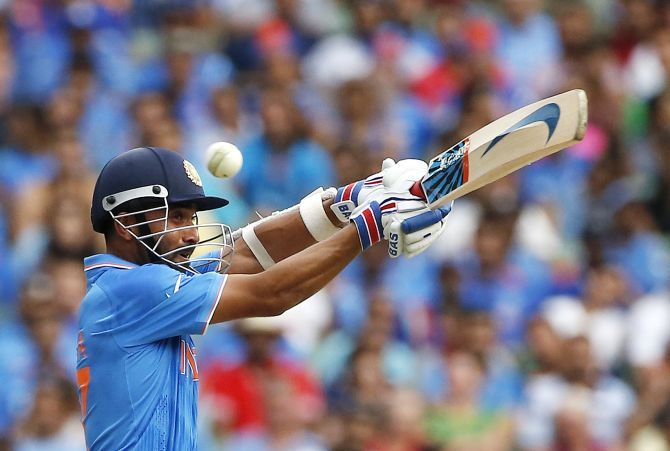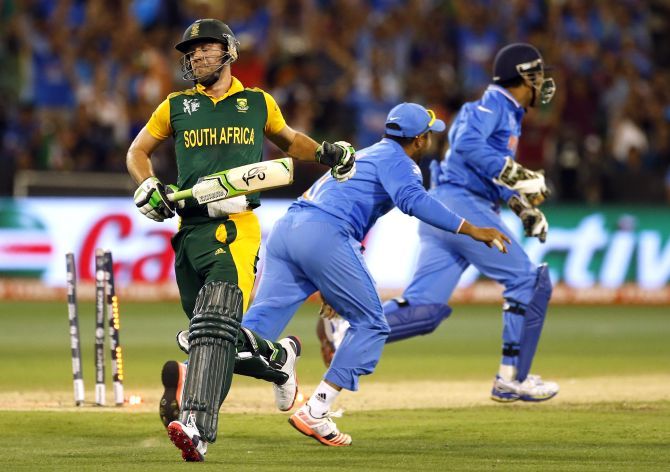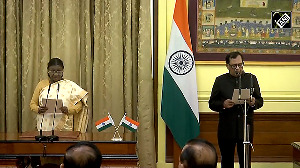'On Sunday against South Africa at the MCG, Shikhar Dhawan took the spotlight and eventually, the Man of the Match award, with a century but it was Ajinkya Rahane’s innings that held the key to India topping the 300 mark.'
Prem Panicker's match report card, for Rediff.com.

We in India are gluttons for glamour, a natural hothouse for “heroes”. Ajinkya Rahane is the antidote we don’t know we need but is good for us anyway. Like spinach.
He is an unprepossessing little fellow who walks to bat in what looks like his elder brother’s gear. His presence at the crease is unfussy, conspicuously lacking in tics and twitchy fidgets. He takes guard once, marks it unobtrusively and gets on with it -- not for him the modern habits of tent-pegging or ditch-digging.
His game is organised along simple lines -- decisive movements forward or back, an undemonstrative felicity against pace and spin and a sure sense of shot selection, built around the ability to drive fluidly off either foot, on either side of the wicket.
He is the wallflower in a team of stars, and it shows in how he is handled: Rohit Sharma is injured so he gets shoved up to open; Virat Kohli needs a bit of cover so he has to walk out at three; the planets are aligned in favour of Raina so he gets dropped down to the tail. The stars get to choose when and where they will bat; Rahane gets whatever slot is left. It is a mark of the man that none of this seems to affect him.
Against South Africa at the MCG today, Shikhar Dhawan took the spotlight and eventually, the Man of the Match award, with a century -- his first since November 2014 against Sri Lanka, and the highest ever against South Africa in a World Cup. But it was Rahane’s innings that held the key to India topping the 300 mark.
When Virat Kohli’s journeyman knock of 46 off 60 (26 singles, as many dot balls, three fours) ended in the 28th over with a mishit pull off a shortish top-spinner from Imran Tahir, India was in indeterminate territory -- 138 for two on the board at an efficient, but by no means dominant, 4.9 runs per over.
Kohli, playing well within himself, and Dhawan, batting himself back to prime form, had put on 127 for the second wicket and set the stage -- but when the vice captain fell, Dhawan was 87 off 102 and, with a century on the horizon, not best placed to take charge of the scoring rate.
Don't Miss: Our complete World Cup coverage
Rahane gave the Indian innings the momentum it needed while providing Dhawan the space to work towards his landmark. More crucially, he slipped a knife deep into South Africa’s biggest chink and twisted with premeditated cruelty.
Vernon Philander had left the field with a hamstring injury after bowling just four overs; Wayne Parnell had to play a more central role in the bowling attack. Dhawan and Kohli had already begun pushing him; Rahane upped the ante on Parnell, starting with a slash to third man followed by a precise pull to midwicket in the 33rd over. In the bowler’s next over, Rahane glided forward to the second ball and slapped a stinging drive to the point boundary.
Parnell, then 6-0-52-0, was visibly wilting. At the other end, AB De Villiers was using JP Duminy to rush through a few of Philander’s overs. Again, Rahane put paid to that by first lofting a drive over extra cover and, when the bowler adjusted his line, clipping him with ease to the fine leg boundary. Without any overt show of aggression, Rahane carved Parnell for 29 runs off 16 balls faced and Duminy for 16 off 11, forcing De Villiers to bring back his frontline bowlers earlier than he would have wanted.
At that, Parnell had some slight reason to feel aggrieved. Off the first ball of the 20th over, he had gotten a ball to climb off length outside off. Shikhar Dhawan, then batting 53 off 73 in a team score of 79/1, failed to keep down a slashing square cut only for Hashim Amla, diving to his right at backward point, to spill a chance that was simple by current international standards.
That inability to ride the bounce when playing his bread and butter cut has been Dhawan’s bugbear throughout a torrid tour of Australia; in the previous game against Pakistan there were signs that the batsman was working on controlling the shot better. Today, against the sharp pace of Dale Steyn and Morne Morkel, he nailed it -- and when Dhawan gets his game square of the wicket on the off side going, he is a totally different player to the walking wicket of recent memory.

The left-handed opener played noticeably straight in the early part of his innings, the first sign of aggressive intent a flowing cover drive in the 8th over, off Vernon Philander; he followed up with a flat-batted extra cover drive.
It was only after finding his range and timing that he began to regularly play the cut and the square drive. But by the time he was done, his wagon-wheel was a graphic illustration of his return to form: of his 137 runs (146 balls), 38 runs had come in the arc through and behind point off fierce cuts and firm glides, and a further 38 in front of the wicket on the off through drives that grew in emphasis as his innings progressed. (The pull, another shot that had been getting him in trouble lately, also came back as his innings flourished -- the arc from square leg to fine leg yielded 37 runs).
The Indian innings was constructed entirely on three efforts: An assured Dhawan, a competent Kohli and an electric Rahane. For the second time in two games, the death overs saw an implosion, largely the result of over-ambition; if the score finally topped 300, it was thanks to an MS Dhoni cameo highlighted by three successive fours off the hapless Parnell.
South Africa was surprisingly flat with the ball and in the field -- barring brief flashes, neither Steyn nor Morkel managed to hit the scorching velocities or find the steepling bounce they are known for; Parnell was a distinct liability, and it was only Imran Tahir’s measured performance that kept the score from hitting the 330-plus mark that seemed possible when Dhawan and Rahane were flowing.
Worse, South Africa were let down by their strongest suit -- fielding. Though de Villiers produced two outstanding run-outs (the first to get rid of opener Rohit Sharma, the second to send back Ravindra Jadeja), the catching and fielding were on the whole a shambles with fumbles and a lot of showboating as fielders kept shying at the stumps from everywhere, for no visible reason. Amla’s drop was merely the most visible of the wounds the Proteas inflicted on themselves in the field, in the process further blunting a bowling attack that was already under pressure.
The 23rd over was in microcosm what good bowling and sharp fielding in tandem can accomplish.
Ravindra Jadeja bowled four tight balls, going wide on the crease to spear the ball in to AB de Villiers and keeping him run-less. The Proteas captain visibly began to fidget. He stayed back to the fifth ball of the over and forced it off his stumps to point. Mohit Sharma, the closest to the ball, had to come in from a deeper sweeper cover -- a certain two.

De Villiers, easily the best of the South Africans between the wickets, turned for his second even as Mohit approached the ball. But Mohit’s pick up was smooth, the throw flat and hard and beside the stumps; Dhoni whipped the bails off with his opposite number still a yard short of the crease. That ended a 68-run third wicket partnership that was beginning to threaten; from that point on, South Africa were visibly out of it.
Ironically, an error in the previous over had set the dismissal up. Ravichandran Ashwin had just been brought on, in the 22nd over. Faf du Plessis clipped the first ball from the off-spinner to deep square leg; Mohit was late coming in and took too long winding up to throw; the batsmen ran an easy two off what was just a single. So noticeable was the vulnerability that Dhoni immediately switched Mohit out and placed the fleet Ravindra Jadeja in that slot.
Sourav Ganguly had made the point during the innings break: Any chase of 300-plus, he said bluntly, puts pressure on the side batting second, no matter how good the pitch and how strong the batting line-up.
South Africa showed clear signs from the outset that the pressure had gotten to them. But -- and what fun to say this -- it was in the field that India applied the squeeze with an almost flawless performance particularly inside the circle; it was the committed fielding of one of the weaker fielders, Mohit, that turned the game decisively in its favour.
If the fielding was world class, the bowling unit performed way above expectations. Umesh Yadav and Mohammed Shami were sharp from the outset; if some of the shorter deliveries flew to the fence off the middle or more often off the edge, they threatened each time they pitched up.
It was Shami’s fuller length that triggered the initial breakthrough; a clearly edgy Quentin de Kock drove without getting on top of the ball and managed only to scoop to the off; Virat Kohli dived forward to take the sort of sharp catch that sets the tone for a fielding unit.
Hashim Amla had made it to 22 (off 28) without ever looking in total command; Mohit Sharma dealt the first of the death blows when he produced a short ball that lifted more than the batsman anticipated. Amla, taken by surprise, badly miscued a hook and Shami, running in from a deeper position on the boundary, took a very sharp overhead catch at deep backward square.
Through de Villiers and du Plessis, South Africa had just buckled down to the task of rebuilding the innings when Mohit produced his bit of magic in the field; he then gilded what was already a very good day for him when, coming back to the bowling crease in the 29th over, he got du Plessis (55 off 71) to give him the charge and flat-bat a simple catch to Dhawan at mid-off.
With the win an almost foregone conclusion, the Indian bowlers turned it up a notch with Ashwin, who mixed up the pace and length of his deliveries, asking questions the Proteas were not equipped to answer. And having already out-batted and out-bowled the South Africans, the Indians rubbed it in to produce another excellent run out.
Again, it was not one of the fielding stars -- Rohit, Raina, Rahane, Jadeja -- at the centre of it. David Miller was stroking fluently (22 off 23) in defiance of what by then was an impossible ask; he swept Ashwin’s fourth ball of the 34th over clean and turned for the second. Umesh Yadav had to run in on a diagonal, field, and throw off-balance; the strength of arm and shoulder powered the ball back just right for Dhoni to rattle the stumps.

In the end, the 130-run margin of victory -- South Africa’s heaviest in World Cup history -- was a fair reflection of the on-field difference between the two teams; the 9.4 overs remaining in the South African innings equally a tribute to an excellent all-round bowling performance backed by fielding of the highest international standards.
To misquote German military strategist Helmuth von Moltke, no pre-match analysis survives contact with reality. Any reading of the form book ahead of this game would have resulted in the following conclusions:
#1. South Africa is the more incisive bowling attack. It wasn’t.
#2. South Africa was the more dangerous, in-form batting unit. It wasn’t.
#3. South Africa was the better fielding side. It wasn’t.
And finally, South Africa are favourites for the title. But on the day, it was India who played like champions.
Are you watching the World Cup? Do share your videos, photos and comments here!










